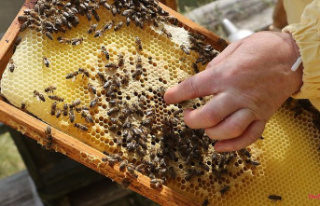They appear almost every bathing season. Where the water shimmers greenish, there are probably blue-green algae. Health authorities then issue warnings of possible dangers, up to and including a ban on bathing. However, only official bathing lakes are tested.
Wiesbaden/Kassel (dpa/lhe) - summer weather and school holidays, the official bathing lakes in Hesse should be in operation. However, people cannot swim safely everywhere. A green-brownish color indicates possible health hazards. The water looks partly like moss. Around a dozen of the officially 61 Hessian bathing lakes are polluted with blue-green algae and the health authorities issue warnings. At the Buga-See in Kassel and at the Arheilger Mühlchen in Darmstadt, bathing is even completely forbidden. "If symptoms such as increased itching, difficulty breathing or skin wheals occur, please see a doctor," says the warnings from the health authorities, which the Hessian State Office for Nature Conservation, Environment and Geology (HLNUG) spreads on its website.
Swimming in the Buga Lake in Kassel has been prohibited since July 12th. Although the body of water is certified as having excellent water quality according to an EU directive for bathing water, there are currently dangers there due to blue-green algae. "After inspection by the health department and the environmental and garden department, the blue-green algae proliferation is so great that health impairments cannot be ruled out and there is an increased safety risk for bathers due to the low visibility," said the north Hessian city about the ban.
"The experts said that if it doesn't cool down permanently or there is heavy rainfall for a longer period of time, the algae situation will not change," said the city's press spokesman, Victor Deutsch, of the German Press Agency. The last time there was such a ban was in 2015. "There's a lot going on there."
The location of the lake is irrelevant. Waters from north to south Hesse are affected. "They can multiply within a short time," said Winfried Staudt from HLNUG. Shallow lakes are more likely to be affected. The weather is a factor, but the problem is mostly man-made. Nutrient enrichment, for example through fertilization in agriculture, but also tributaries that bring in sewage played a role. Whether climate change is a reason is difficult to say, but the current weather is of course favorable to growth.
"Blue-green algae are not actually algae at all, but so-called cyanobacteria. Some of them contain a green-blue dye, which has given them the colloquial name "blue-green algae"," says the website of the Bund Nature Conservation Union. They are mainly found in rivers and lakes, but can occasionally also appear in seawater. Some of these bacteria could develop toxins. Contact can cause skin irritation and allergic reactions, and in worse cases nausea, diarrhea, fever or respiratory diseases.
Blue-green algae could also be dangerous for pets like dogs and cats if they soak the water, Staudt said. "But you also do them a bit of an injustice, they are not all toxic." Around 3.5 billion years ago, they were the first creatures to carry out photosynthesis and produce oxygen.
According to Staudt, only the official bathing waters are checked. If there is an algae infestation, the measures range from simple warnings to bathing bans. All other bodies of water would not be checked. "Swimming there is at your own risk anyway."
According to the Federal Environment Ministry, the EU Bathing Water Directive was amended in 2006. The federal states are responsible for enforcement. The water samples are examined several times during the bathing season according to a fixed monitoring schedule.












